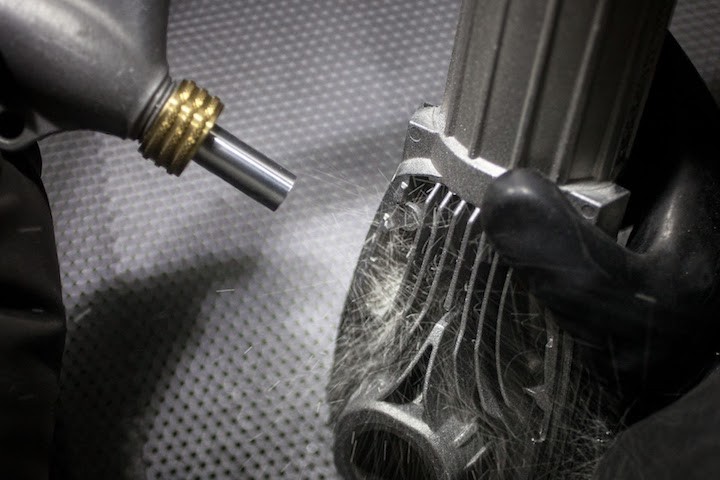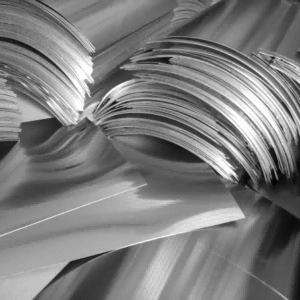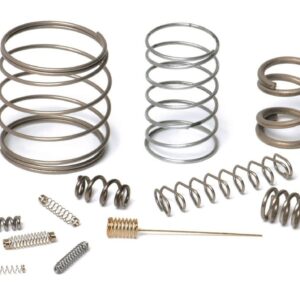Bead blasting is a surface finishing method that cleans, smooths, and improves surfaces while projecting high-pressure spherical media: glass or steel beads. Precision and safety are attained by shooting beads at the workpiece using a bead blaster gun in a sealed cabinet. Bead blasting media are spherical, unlike angular sandblasting media, creating a unique dimpling effect that leaves an even, matte, or satin finish without removing much material. This less aggressive method benefits situations needing minimum material removal and a nicer finish than sandblasting.
Furthermore, bead blasting preserves fragile components and enhances surface qualities in industries such as aerospace, automotive, and medical manufacturing. Based on finish and material qualities, media type and size are key. For example, glass beads are soft and good for aluminum and stainless steel. On the other hand, steel beads are stronger and perfect for cast iron.
How Does Bead Blasting Work?
Place the workpiece in a high-quality bead blasting cabinet made of steel for stability under high pressure. A compressed air-powered bead blaster gun blasts beads at the workpiece within the cabinet. Bead size, material, and air pressure affect the process. Smaller beads provide a satin-like surface. Larger beads roughen it. Inhaled dust and dirt may be harmful, so the cabinet must seal well. The view window, shielded by changeable sheets, lets operators observe the operation safely.
Blasting gloves are incorporated inside the cabinet to protect and grip for long-term control. Bead blaster guns, either foot or hand-pedal-operated, should depend on blasting length and intensity. Long-term use of foot pedal guns lowers hand fatigue. Keep the pressure low, around 50 PSI, to avoid bead breakage and optimize surface finishing on delicate materials. Remove rust or oxides before finishing the piece to improve the finish since the beads polish rather than cut through them.
Tools and Materials Used in Bead Blasting
Bead Blasting Media
- Glass Beads.
- Steel Beads.
- Ceramic Beads.
- Aluminum Oxide.
- Plastic Media (e.g., Urea).
Blasting Cabinet
- High-quality steel construction.
- Durable, high-strength legs.
- Seamless cabinet sealing.
- View window protection.
- Replaceable protective sheets for windows.
Blasting Guns
- Foot pedal-operated guns.
- Hand pedal-operated guns.
Blasting Gloves
- Built-in for solid grip and safety.
Compressed Air System
- Provides the necessary pressure for blasting.
Protective Gear
- Safety goggles.
- Protective clothing.
Pros and Cons of Bead Blasting
Advantages of Bead Blasting
Many industries use bead blasting for surface finishing due to its benefits. First of all, media recycling makes it cost-effective. For instance, glass beads may be reused 30 times to save material expenses. Also, bead blasting is less harsh on materials than sandblasting. The milder approach preserves the material’s integrity for sensitive aerospace and medical components.
Bead blasting maintains the workpiece’s basic color, which is another benefit. Bead blasting provides a bright, homogeneous finish, unlike harsher treatments. Additionally, this technique is green. Lead-free soda-lime glass beads do not leave residues or silica dust, which decreases operator health concerns. Finally, the process may be used on aluminum, stainless steel, and other materials for better component durability and aesthetics across industries.
Disadvantages of Bead Blasting
Bead blasting has advantages, but technical issues restrict its use in specific situations. It is unsuitable for tight tolerance applications. A thin layer of material is removed to affect dimensional precision. Precision engineering requires exact measurements, so this constraint is important.
Bead blasting takes time with tougher materials. Lower pressures slow the process to avoid damage, which is less efficient for high-throughput uses. The manual aspect of the procedure increases labor. Professionals must supervise the process to prevent over-blasting and surface deterioration. Skilled personnel raises operating costs and product quality unpredictability.
Applications of Bead Blasting
- Peening, deburring, cleaning, finishing, polishing, and cosmetic finishing.
- Removing paint, rust, scale, and calcium deposits.
- Smoothing rough edges.
- Achieving matte and satin finishes.
- Hiding surface imperfections.
- Increasing surface hardness and durability.
- Stress relief for metals.
- Surface preparation for anodizing, plating, and coating.
- Automotive, aircraft, marine, medical, and military parts finishing and preparation.
- Restoration of metal parts.
- Surface texturizing for improved aesthetics.
- Surface preparation for high-performance sports equipment.
Metals that Can Bead Blasted
- Aluminum
- Titanium
- Stainless Steel
- Brass
- Copper
- Cast Iron
- Plastics
- Rubber
- Glass
Tips for the Best Bead Blasting Result
Use of Low Pressure for Bead Blasting
Bead blasting works best with low pressure. For longer bead life and lower surface damage, start at 50 PSI (3.5 Bar). Dust and debris from shattering beads under high pressure ruin the finish and pollute the workstation. Under pressure, crushed particles embed into the material to damage crucial surfaces. For example, bead-blasting aluminum engine components require low pressure to provide clean surfaces without impurities that might affect engine performance.
Scraping Away Oxides or Rusts before Blasting
Rust and oxide coatings hamper bead blasting. These hard layers resist bead impact and generate uneven finishes. For that purpose, remove oxides and rust using aluminum oxide or crushed glass before bead blasting. For example, aluminum oxide at 60-80 grit may remove oxide layers to prepare the surface for bead blasting. Such type of pre-treatment guarantees that beads accomplish an identical smooth finish for components with tight aesthetic and functional criteria.
Adding Masking Callouts for Critical Features
Mask O-ring grooves and small pitch threads to circumvent bead impact. Masking keeps these regions functioning and prevents abrasion. Cover these features with high-temperature masking tape and custom-fit plugs. For instance, masking keeps threaded parts precise when bead-blasting medical device components. As a result, it helps avert assembly and performance issues. Technical drawings should clearly include masking requirements to reduce blasting errors.
Specifying the Media and Grit Size
Choosing the right medium and grit size is vital for the finish. Aesthetic applications, including consumer electronics housings, benefit from fine glass beads (80-100 mesh)’ satin finish. Coarse beads (30-40 mesh) are rougher and suit industrial items that need more coating adherence. Fine glass beads are used to satisfy industry requirements for smooth bead blasting of aerospace components. Provide the medium type and grit size for batch uniformity in project specs.
Difference between Sandblasting and Bead Blasting

Materials, speed, efficiency, health, and material impacts vary between sandblasting and bead blasting. Sandblasting removes heavy coatings, rust, and corrosion using silica sand or equivalent abrasives, including aluminum oxide or garnet, with a Mohs hardness of 8-9. However, it may change fragile components’ dimensions. On the other hand, spherical media like glass beads or steel shot have a lower Mohs hardness of 5.5-7.5, making bead blasting gentler on surfaces.
Glass beads may be recycled and provide a smooth finish without altering the size. Durable and reusable steel shot peens and deburrs while increasing metal fatigue resistance by 17.14%. Likewise, sandblasting is quicker for heavy-duty cleaning and surface profiling owing to its abrasive nature. Nevertheless, its high silica dust output poses health risks like silicosis, which demands respiratory protection and ventilation equipment. Despite being slower, bead blasting creates less dust and renders workers safer. A brighter finish without impurities is also obtained.
Contact ShanenTech for expert bead blasting services and guidance.




